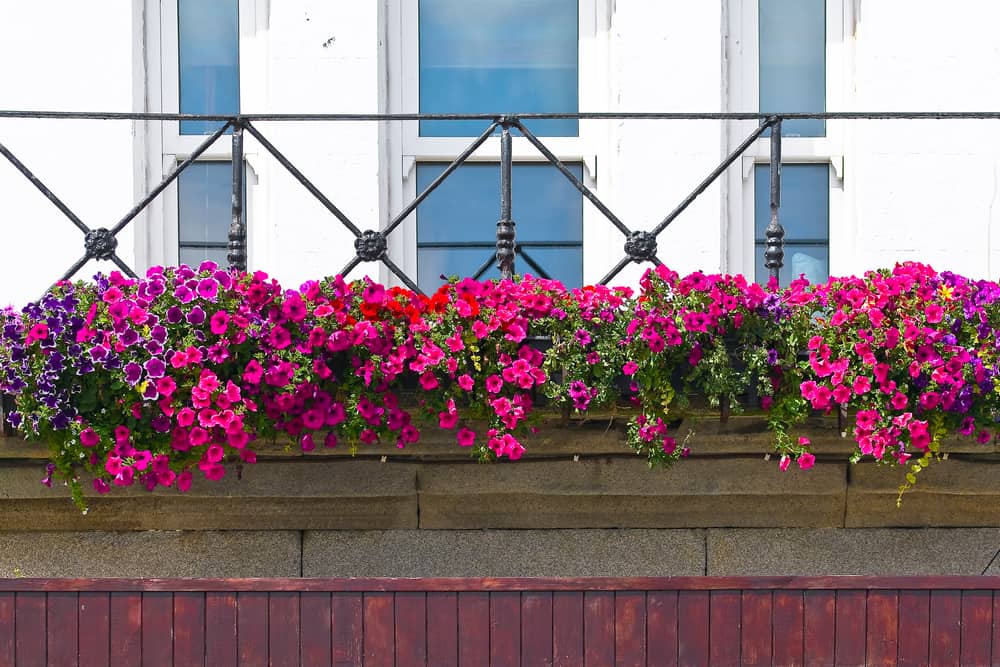Trailing plants are a great addition to balconies and small outdoor spaces because they don’t take up much room. Specifically, you don’t need a lot of floor space for a large trailing plant because most of their growth is done as hanging vines.
In this article, we’ll look at the 7 best trailing plants for balconies and other small outdoor spaces.
What is a Trailing Plant?
A trailing plant is one that grows vines or tendrils rather than stems or branches. Trailing plants can either grow from a hanging pot or as ground cover, depending on what the plant prefers.
For example, we could consider pumpkins and other gourds to be trailing plants, as they have long vines that creep across the ground. You probably won’t be growing them as decorative plants though!
Trailing Plants vs. Climbing Plants
It’s useful to distinguish between climbing and trailing plants when working out what to buy for your outdoor space. The main difference is that climbing plants can support themselves using suckers, roots or tendrils. These fix to a structure, allowing the plant to climb.
You can grow trailing plants as climbers, but you’ll need to tie them in place. This is common with ornamental roses, which can look great trained up a wall, but you’ll have to fix them in place.
Creeping and trailing plants are basically the same thing. If there’s any real difference, it’s that creepers stick to the ground, whereas trailers will grow vertically, too.
To find out more, check out out article about climbing plants.
Why Choose Trailing Plants
After asking, what is a trailing plant, we should move on to why. There are 2 main reasons for balconies:
Space
Trailing plants save on space because they often don’t need a large pot. For example, something like ivy can be kept in a relatively small container while providing a lot of foliage.
Decoration
Much like climbing plants, trailers are useful for decorating vertical spaces. While you might use a climber for a wall, a trailing plant would be ideal for covering your balcony railing. Something with large, striking foliage (such as ivy or grape) would work well. Of course, this reason applies to other spaces like decks and patios.
Important Things to Know for Trailing Plants
Choosing the right trailing plant for your space isn’t difficult. Even so, bear the following in mind when making your selection.
Support
Depending on the type of trailing plant, it may need support. This isn’t the case for ground-covering plants, but you might not have them on a balcony.
The support can be as simple as your balcony railing, but you might need to provide a trellis. Alternatively, trailing plants can look great when kept in a hanging pot.
Growing Conditions
Make sure you choose a trailing plant that suits your space. For example, an uncovered balcony may benefit from plants that prefer full sun, whereas a covered balcony might work best for shade-loving plants. The same is true for watering.
While this isn’t a strict issue, finding plants that suit your environment will cut down on maintenance.
Pots and Planters
Large trailing plants will need sizeable pots if you want them to reach their full potential. However, compared to trees, bamboo, or other large plants, you can keep them in fairly compact containers.
It’s possible to find trailing plants that suit all manner of containers, including hanging pots and railing planters. For these, you’ll want smaller plants otherwise they’ll become rootbound very quickly.
Maintenance
The most important bit of maintenance you can do on a trailing plant is encouraging bushy growth. You do this by pinching off growing tips to force the plant into creating side shoots. The result is a much fuller plant because it doesn’t focus on singular large stems.
Unlike with climbing plants, you shouldn’t have as much issue with limiting growth. A trailing plant’s vines will just get longer, but the worst thing that’ll happen is they’ll encroach on someone else’s space. Climbing vines can cause damage to buildings if left unattended.
For this reason, trailing plants are probably better for renters than climbing plants. If nothing else, they’re easier to detach from their supports if you need to remove them.
Best Trailing Plants for Balconies or Decks
When we put this list together, we thoughts about the common uses for trailing plants on balconies or decks, and we’ve selected our favorite trailing plant for each.
Best for Hanging Baskets: Ivy
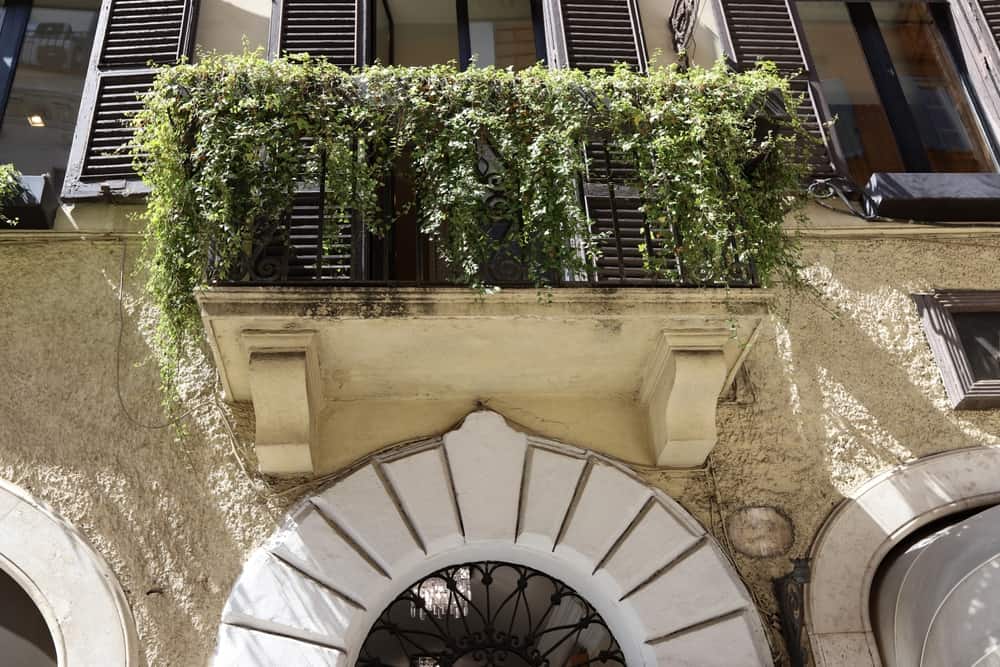
Ivies are incredibly easy plants to grow and come in a range of sizes and colors. English ivy is a beginner’s favorite, but needlepoint ivy has a more striking appearance. Whatever type you choose, it’ll do well in almost any growing conditions.
Keeping ivy in a small hanging basket (like this) will make a great decoration for awkward corners.
However, if you want a bigger plant, go with a large rectangular planter (like this) and stick with Boston ivy. You could then trail it along your balcony railing for privacy coverage.
Pros
- Available in different sizes and colors
- Easy to grow almost anywhere
- Works well as a decorative plant
Cons
- Some types of ivy are climbers and have damaging root suckers
- Ivy is toxic to dogs, although they shouldn’t show much interest
Best for Flowers: Black-Eyed Susan

Black-eyed Susan has delicate yellow flowers with striking black centers. Its vines can quickly grow up to 3ft. long, making it great for growing up a trellis (like this) or wall.
Growing it in pots will stunt its growth slightly, but this isn’t a massive issue. Aim for a 5-gallon planter (like this) and fertilize regularly. One of the best things about black-eyed Susan is that pollinators love it.
Pros
- Grows quickly
- Products an abundance of flowers
- A favorite with pollinators
Cons
- Requires more root space than other trailing plants
Best for Railing Planters: Nasturtium
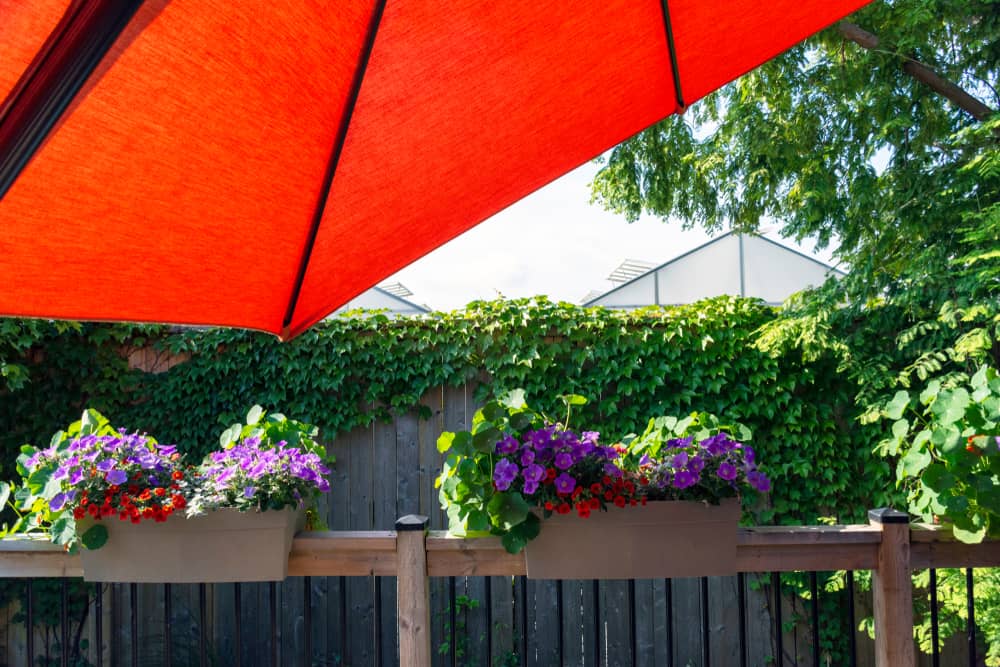
Choosing a flowering trailing plant for a railing planter was difficult. We picked nasturtium because it’s simple to care for and produces hundreds of bright flowers all summer long.
A railing planter (like this) will easily hold 2 plants, which will give you plenty of trailing vines. Pollinators love them, as do slugs (making it a good trap crop). Better yet, the leaves and flowers are edible.
Pros
- Easy to look after
- Great for railing flowers
- It’s easy to germinate seeds for next year’s plants
Cons
- A favorite of slugs, although this shouldn’t harm the plant
Best for Railing Coverage: Grape Vine
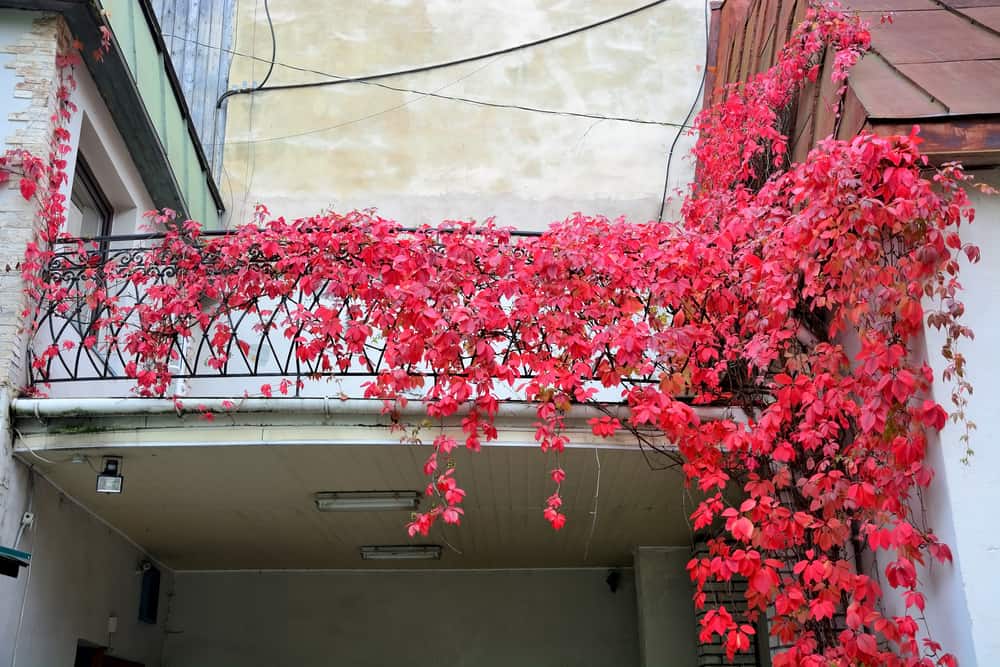
Sure, grape vines might not suit every climate, but they’re massive trailing plants that can provide privacy once mature. Some species of grape vine can reach up to 80ft. long in the right conditions!
If you want interesting color throughout the year, varieties such as Purpurea, Brant, Cascade and Dornfelder all turn red in the fall. However, don’t expect to actually get edible grapes off them, although this is a possibility if your climate is suitable.
Pros
- Massive growth and bushy foliage
- Ideal as railing coverage
- Fairly easy to care for
Cons
- Grapes and vines are toxic to dogs
- You can’t guarantee you’ll get fruit
Best for Fruit: Strawberries
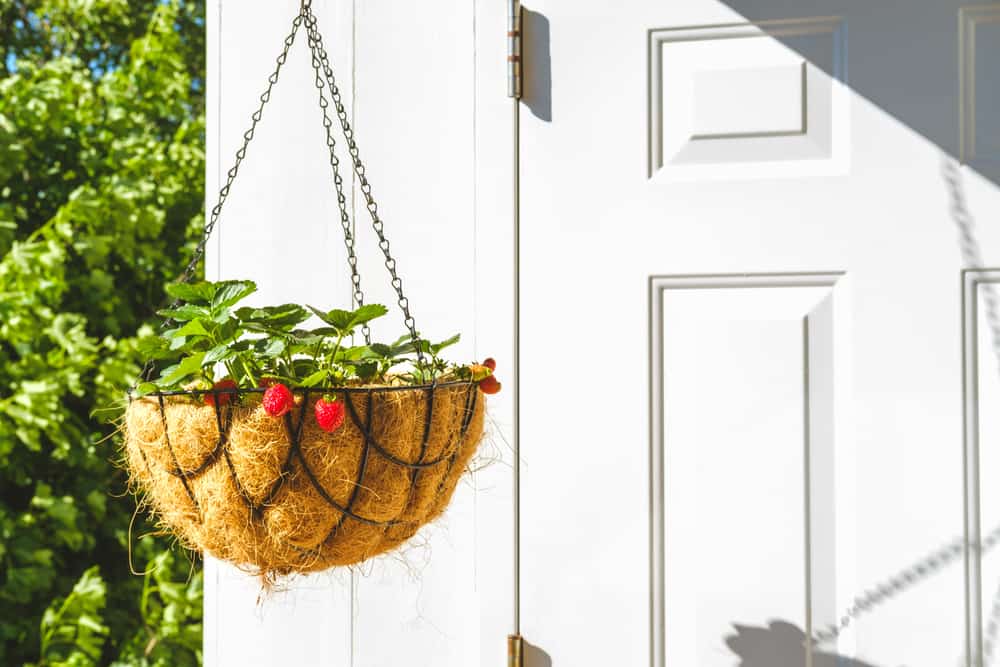
If fruit is a priority for your trailing plants, stick to strawberries. They might not be your first thought for a trailer, but they meet the brief. Strawberries reproduce by sending off runners, which eventually provide a lot of ground coverage if left alone.
Strawberries look great in hanging baskets (like this), window boxes (like this), or just about any other pot you might want to put them in.
Pros
- Surprisingly easy to grow
- Suitable for all kinds of pots
- Happy with covered and uncovered spaces
Cons
- Not especially decorative
Best for Beginners: Petunias

Petunias could have also been the top pick for flowering trailing plants, but their ease of care makes them perfect for beginners. You simply buy some young plants from a gardening store, put them in a pot and let them do their thing.
Petunias will work well in railing planters, hanging baskets, and pots on the ground. With the latter option, be prepared for them to end up pretty much everywhere. The only thing worth knowing about growing conditions is that they don’t like frost.
Pros
- Wide range of colors
- Produce abundant flowers
- Last until mid-fall
Cons
- Annuals – you’ll need to buy more the following year
Best for Warm Climates: Pothos
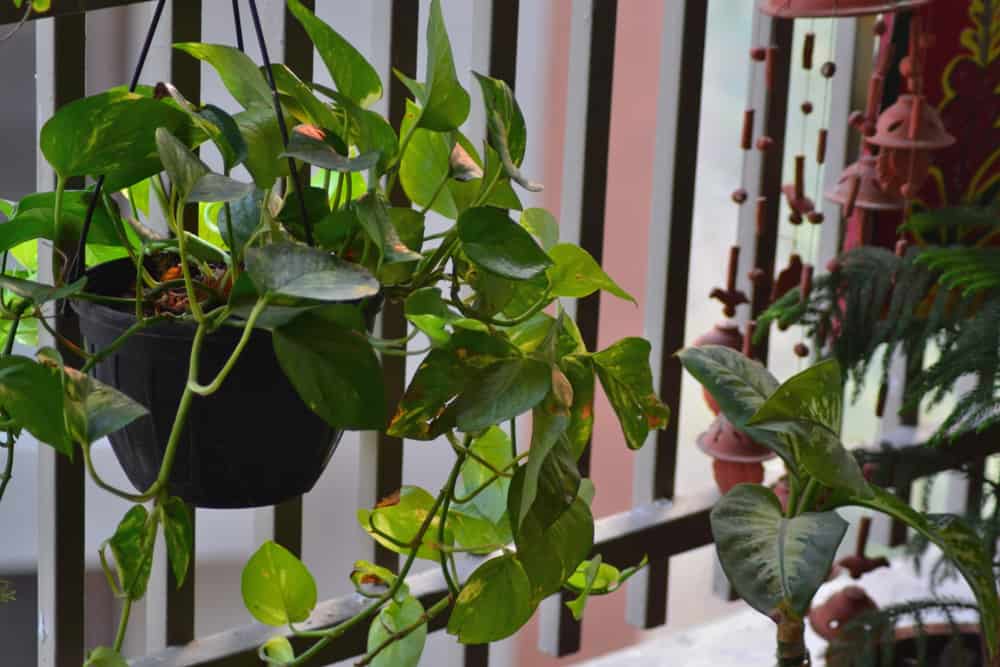
Pothos is one of the most classic trailing houseplants, but nothing is stopping you from growing it outside. Bear in mind that it’s a tropical plant, so it’ll need pretty warm conditions.
Pothos can be grown up supports, along railings, or left to hang from its pot. You can check out our article on the best types of pothos to narrow down your options.
Pros
- Interesting colors and foliage patterns
- Relatively low maintenance
- Suitable for different pots and spaces
Cons
- Needs a warm climate
Final Thoughts on Trailing Plants
Hopefully, this guide has given you some inspiration on the best trailing plants for your balcony or outdoor space. Granted, this is just a small taste of the available options, but it should highlight that trailing plants are just as suitable as climbers, perhaps even more so.
